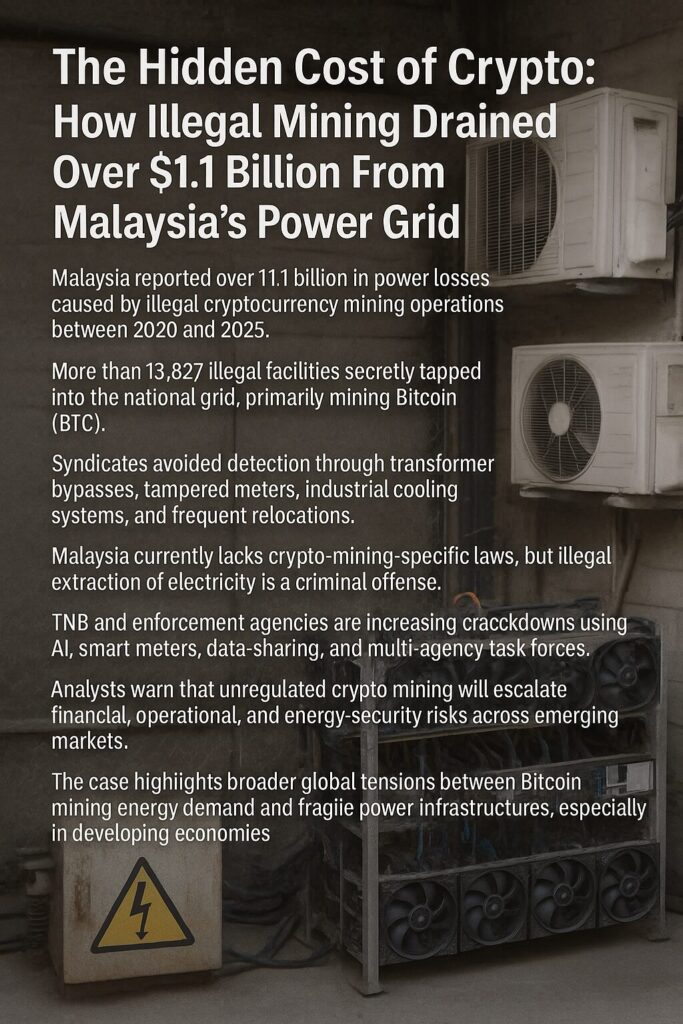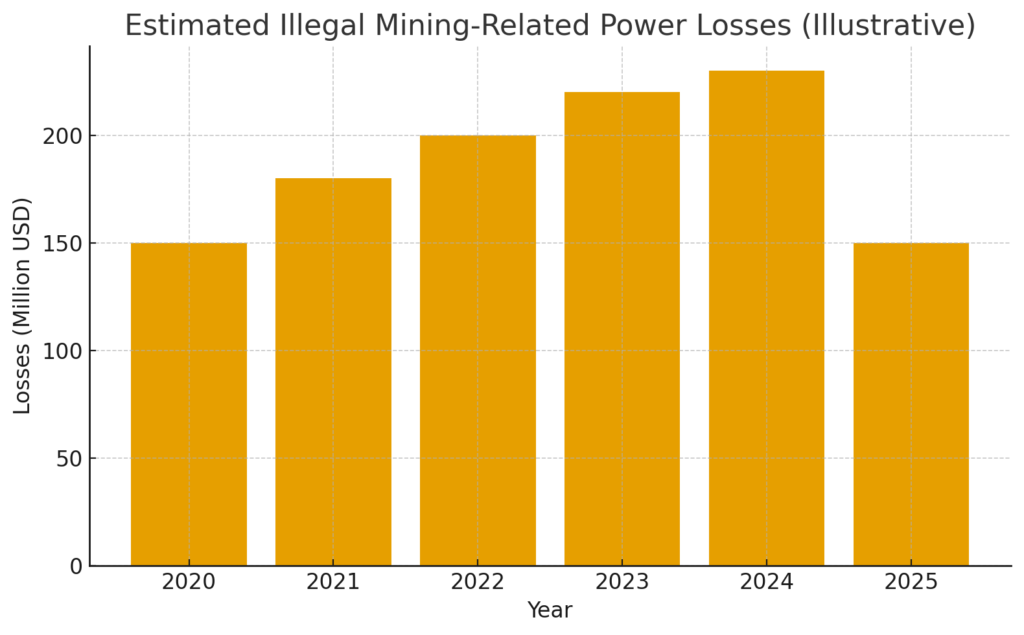
Main Points :
- Malaysia reported over $1.1 billion in power losses caused by illegal cryptocurrency mining operations between 2020 and 2025.
- More than 13,827 illegal facilities secretly tapped into the national grid, primarily mining Bitcoin (BTC).
- Syndicates avoided detection through transformer bypasses, tampered meters, industrial cooling systems, and frequent relocations.
- Malaysia currently lacks crypto-mining-specific laws, but illegal extraction of electricity is a criminal offense.
- TNB and enforcement agencies are increasing crackdowns using AI, smart meters, data-sharing, and multi-agency task forces.
- Analysts warn that unregulated crypto mining will escalate financial, operational, and energy-security risks across emerging markets.
- The case highlights broader global tensions between Bitcoin mining energy demand and fragile power infrastructures, especially in developing economies.

I. Introduction — Illegal Mining as a Global Vulnerability
Illegal cryptocurrency mining is no longer a fringe cybercrime—it has become one of the most financially damaging forms of energy theft across developing economies. Malaysia’s national utility, Tenaga Nasional Berhad (TNB), provided one of the strongest data-based warnings to date: over $1.1 billion in stolen electricity across just five years.
From 2020 to August 2025, 13,827 illegal mining operations were identified as having siphoned electricity directly from the grid. These operations, mostly running Bitcoin miners (ASICs), consumed industrial-level power without paying for it, creating severe national-scale losses.
This article examines what happened in Malaysia, how illegal mining operations function, why the problem is spreading globally, and what it means for crypto investors, miners, utilities, and policymakers.
II. The Scale of Losses — Over $1.1 Billion in Electricity Theft
TNB reported that 11.46 billion Malaysian ringgit—approximately $1.10–$1.11 billion USD—has disappeared into illegal mining facilities. This figure is not speculative; it represents recorded losses from bypassed meters, direct tapping into transformers, and destroyed energy infrastructure.
Why the losses are so large
- ASIC miners consume enormous power
A typical Bitcoin ASIC consumes 3,000–3,500 watts.
An illegal farm with 500 ASICs may use the same power as a small factory. - Electricity costs in Malaysia are heavily subsidized
Subsidies lower the cost of power for citizens—but illegal miners steal it entirely free.
This distorts the economics of local power markets. - Scaling through syndicates
These operations were rarely individual miners.
Organized groups relocated every few months to stay ahead of authorities.
The scale reveals that unregulated crypto mining is now an emerging black-market industry, not merely a digital hobby.
III. How Illegal Mining Operations Avoid Detection
Malaysian authorities described sophisticated, multi-layered evasion strategies:
1. Direct Transformer Bypass
Mining farms connected cables directly to distribution transformers, entirely avoiding the meter system.
This method makes detection difficult until local grid instability occurs.
2. Meter Tampering
Some facilities kept meters installed but disabled or slowed the reading mechanism.
3. Industrial-Grade Cooling and Sound Dampening
To avoid suspicion:
- soundproofing rooms
- industrial air-conditioning
- heat ventilation systems
These disguised the typical airport-like loudness and heat signature of ASIC clusters.
4. Frequent Relocation
Illegal facilities moved every 2–4 months, making enforcement reactive rather than preventive.
The system resembled drug-lab relocation patterns—small cells, short cycles, and minimal paper trails.
IV. Multi-Agency Crackdowns and New Enforcement Tools
Malaysia responded with an expanded task force involving:
- TNB (national utility)
- Police
- Malaysian Anti-Corruption Commission
- Energy Commission
- Local Councils
Thousands of ASIC machines have already been seized.
Smart Meters & AI-Based Monitoring
TNB began deploying:
- smart meters at substations
- real-time anomaly detection
- AI systems to flag abnormal load signatures
These upgrades allow faster identification of:
- sudden voltage drops
- unusually stable high loads
- transformer stress patterns
- nighttime electricity spikes
The utility also built a database of suspicious landlords and tenants to identify recurring offenders.
As countries modernize their grids, AI-powered monitoring will become the global standard for combating energy-related crypto crime.
V. Why Malaysia? — A Perfect Storm of Vulnerabilities
Illegal miners choose Malaysia for five main reasons:
1. Low subsidized electricity prices
Subsidies create a financial incentive—especially when stolen.
2. No dedicated crypto-mining law
There are energy-theft laws, but no specialized mining policies.
This gray zone creates slow enforcement cycles.
3. Rapid adoption of Bitcoin and blockchain industries
Malaysia has growing digital-asset participation, making hardware procurement easier.
4. Industrial infrastructure in rural areas
Large warehouses and abandoned factories are plentiful.
5. High ASIC profitability in 2021–2024
During the bull cycle, Bitcoin’s rising price made illegal mining incredibly lucrative.
VI. Global Context — Illegal Mining Is Rising Everywhere
The Malaysian case is not isolated. Worldwide, illegal crypto mining has been linked to:
- Iran: subsidized energy + mining crackdowns
- Kazakhstan: grid failures partly due to unregistered miners
- Russia: underground mining in industrial zones
- China: surviving illegal farms after the mining ban
- Latin America: small but fast-growing illegal clusters
Energy-Based Risks
Illegal mining poses three systemic threats:
- Grid instability
Sudden voltage drops can trigger blackouts. - Safety hazards
Improvised wiring causes fires and equipment explosions. - Economic distortion
Utilities lose revenue, increasing costs for compliant consumers.
Analysts estimate that illegal mining worldwide may account for hundreds of millions of dollars in losses annually for developing countries.
VII. Implications for Crypto Investors and the Mining Ecosystem
For legitimate crypto businesses—including cloud miners, OTC desks, wallet operators, and mining farms—Malaysia’s case offers several lessons:
1. Energy Compliance Will Become a Standard Requirement
Countries will tighten rules around:
- mining registrations
- energy audits
- location approvals
- environmental reporting
Expect mining governance to resemble environmental compliance in traditional industries.
2. Power Pricing Will Change
Subsidies may be removed or restructured, especially for high-risk categories.
3. Regional Mining Hubs Will Shift
Illegal activity pushes regulators to favor:
- renewable-energy mines
- industrial-zone mining
- licensed mining operators
Countries like the UAE, Canada, and the U.S. will likely attract more regulated miners.
4. AI Will Reshape Mining Surveillance
AI-driven energy monitoring will detect power leakage faster, reducing illegal operations.
VIII. The Future — What Comes Next in Malaysia
Authorities expect:
- new mining-specific regulations
- licensing systems for legal operators
- tougher penalties on landlords
- inter-agency digital reporting tools
- integration of AI and national grid monitoring
This shift mirrors global trends—crypto mining is becoming a regulated industrial activity, not a small-scale technical practice.
IX. Conclusion — A Wake-Up Call for Emerging Markets
Malaysia’s $1.1 billion electricity loss is a warning:
crypto mining has matured into an energy-intensive industrial operation with real-world consequences.
For the crypto industry, this signals:
- the need for cleaner power sources
- compliance-focused mining models
- transparent reporting
- proactive regulation
For investors, regulated mining operations will become more trustworthy and more sustainable, especially for institutional participation in BTC infrastructure.
For governments, failing to regulate mining early results in massive energy losses and safety risks.
Illegal crypto mining is not a digital problem—it is a national infrastructure threat.
Malaysia’s experience demonstrates why energy security will be central to the future of Bitcoin and proof-of-work mining.

